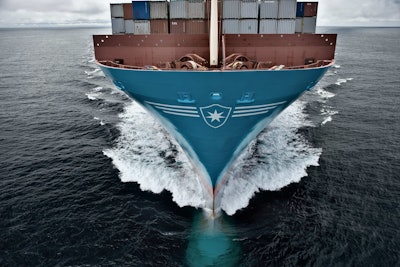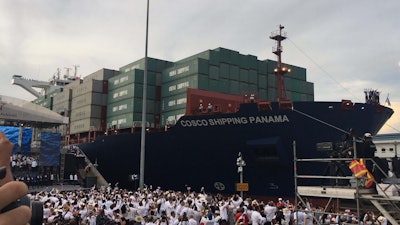This is the third part of a three-part series on the Panama Canal’s expansion. Click here to see Part 1, and click here to see Part 2.
 Could a widened Panama Canal significantly impact freight patterns in North America?
Could a widened Panama Canal significantly impact freight patterns in North America?When the U.S. Army Corp of Engineers completed construction of the Panama Canal in 1914, it ushered in a new age of world trade. The canal connected the Pacific and Atlantic oceans with a 50-mile channel, shortening the shipping lanes between continents by thousands of miles.
The Panama Canal, which could accommodate container ships with capacities of up to 5,000 twenty-foot equivalent units (TEUs), has gone largely unchanged in 102 years. That all changed on June 26, when the Cosco Shipping Panama containership – a 9,400-TEU behemoth measuring 984 feet long and a 158 feet wide – navigated its waterways. The event marked the end of a nine-year project by the Panama Canal Authority to create two larger lock systems to allow up to 14,000-TEU ships to sail through the canal, effectively doubling or tripling the canal’s throughput.
The implications for global maritime trade are significant. Many shipping companies have added the larger “Neopanamax” vessels to realize economies of scale, and the Panama Canal expansion literally unlocks a new door for these ships to traverse the globe. Some estimates call for the Panama Canal’s market share of global shipping traffic to increase from 5 percent to 8 percent in the coming years as a result of the expansion.
“The expansion provides us with more options, most notably to our Asia to South America and Asia to U.S. East Coast routes,” says Anders Boenaes, head of network for Maersk Line, the Denmark-based and world’s largest shipping company with more than 600 ships. “It is likely that Maersk Line will make increased use of the expanded Panama Canal and adjust one or more services with larger vessels to begin sailing through its new locks,” Boenaes said Anders.
 The newly completed Panama Canal Expansion allows Neopanamax ships with nearly three times more capacity to cut several days or weeks off transit times from Asia to the U.S. East Coast.
The newly completed Panama Canal Expansion allows Neopanamax ships with nearly three times more capacity to cut several days or weeks off transit times from Asia to the U.S. East Coast.The eastern United States is a major customer for the Panama Canal. More than 60 percent of all container traffic through the canal either originated from or is destined for East Coast ports.
In North America, the million-dollar question on everyone’s mind is how, if at all, will the expanded Panama Canal impact U.S. freight patterns and trucking operations. If it does, it will likely come from container traffic moving from ports on the West Coast to key ports on the East Coast, including Houston, Savannah, Norfolk and the Port of New York and New Jersey.
Any migration of eastbound container traffic from West Coast to East Coast would result in less rail and long-haul truck services and increase those services along the eastern U.S. seaboard. The degree to which that will happen remains unknown, but even a 10 percent shift could have major ramifications for surface freight patterns.
The consensus is any shift won’t happen overnight. While most major East Coast ports can accept up to 10,000-TUE ships, they are scrambling to complete billion-dollar projects to host the 14,000-TEU ships capable of passing the Panama Canal. The Port of New York and New Jersey is set to complete the Bayonne Bridge navigational clearance project late next year, while the Port of Charleston and Port of Savannah are currently working on dredging projects to allow the largest Neopanamax ships to reach their ports in the next two years.
“The shift won’t be immediate, but it will happen sooner rather than later,” says Danny McComas, president of MCO Transport, a Wilmington, N.C.-based container drayage and domestic truckload company.” The carrier has already begun adding chassis and tractors to its fleet in anticipation of volume increases, but McComas insists the company is largely taking a “wait-and-see attitude.”
“We expect cargo expansion as a result of the widened Panama Canal to be incremental but steady as shipping lines take advantage of cost savings of an all-water route to serve the U.S. Southeast market,” says Griff Lynch, incoming executive director for Georgia Ports Authority. In addition to port improvements at Savannah and Brunswick, the state of Georgia is making improvements to inland truck and rail access to ease congestion ahead of the anticipated volume increase.
“In 10 years, East Coast port activity will have to be highly efficient,” adds McComas. “Many ports are congested and close to capacity right now. There will have to be a lot of automation to move freight in and out of ports more quickly.”
Boenaes says its West Coast port strategy will not change for time-sensitive shipments headed to the East Coast. “We will continue that service through West Coast ports then truck or rail because that is fastest,” he says. But the cost advantages for Maersk Line and is peers are enticing for East Coast customers willing to wait four or five extra days for freight to move through Panama rather than West Coast ports.
 The Cosco Shipping Panama was the first Neopanamax ship to navigate the Panama Canal. It has a 9,400-TEU capacity and measures 984 feet long and 158 feet wide.
The Cosco Shipping Panama was the first Neopanamax ship to navigate the Panama Canal. It has a 9,400-TEU capacity and measures 984 feet long and 158 feet wide.The Panama Canal expansion also provides flexibility for shipping companies when work stoppages and other port disruptions occur as have happened at West Coast ports in recent years. Another attractive draw for shippers servicing East Coast ports through the Panama Canal rather than Transpacific routes between Asia and West Coast ports is backhaul.
Maersk Line recently added a new line service to the East Coast, and, “exports from the Gulf area are stronger than anticipated and have become balanced with the inbound [volume],” says Boenaes. “We will bring a full ship inbound to a West Coast port and it will leave outbound only one-third full. The balance between the East Coast and Asia is better.”












